Understanding the different camping stove fuel types for your camping stove is critical for a successful outdoor cooking experience. Each option, from gas canisters to liquid fuels, comes with its own set of benefits and considerations.
Choosing the wrong type of fuel for your camping stove can lead to frustrating cooking experiences in the wild. The wide range of different fuel options available might leave you confused about what to buy for your next trip.
Have you ever found yourself on a wild camping trip, stove at the ready, only to realize that the fuel you’ve brought along isn’t suitable for the conditions or your cooking needs? Whether it’s struggling with a gas canister in the cold or managing the mess of liquid fuels, the wrong choice can quickly complicate your outdoor meals.
This guide breaks down the most common fuel types used in camping stoves, helping you to choose the best option for your specific situation. Whether you’re scaling a mountain or setting up camp by a lakeside, knowing the ins and outs of your fuel can make all the difference.
TL;DR:
Explore the pros and cons of different fuel types for camping stoves.
Understand why gas canisters are a popular choice among campers.
Discover the scenarios where liquid fuels might be your best option.
Make an informed decision for your next outdoor cooking adventure.
Now, let’s dive into the details and ensure your next meal under the open sky is both delicious and effortlessly prepared.
This article contains affiliate links. If you buy through them, I may earn a commission at no extra cost to you. Learn more here
Which Camping Stove Fuel Types are Best?
As with most gear choices for the outdoors, pinpointing the ‘best’ when it comes to camping stove fuel isn’t a one-size-fits-all affair.
The ideal fuel for your stove hinges on the specific circumstances and environments you anticipate encountering on your adventures. Cold temperatures, for instance, can significantly influence fuel performance, making certain options more viable than others.
Rather than searching for a universal solution, it’s more practical to weigh up the characteristics of different fuel types.
Liquid fuel stoves and canister stoves, for example, each shine under distinct conditions and cater to varying needs. By dissecting the pros and cons of each, and understanding the scenarios where each excels, you’ll be equipped to choose a stove—and its fuel—that aligns perfectly with your outdoor cooking requirements.
Now, let’s unpack the details of these fuel types to guide you toward making a choice that will enhance your culinary experience in the great outdoors.
Gas Canisters
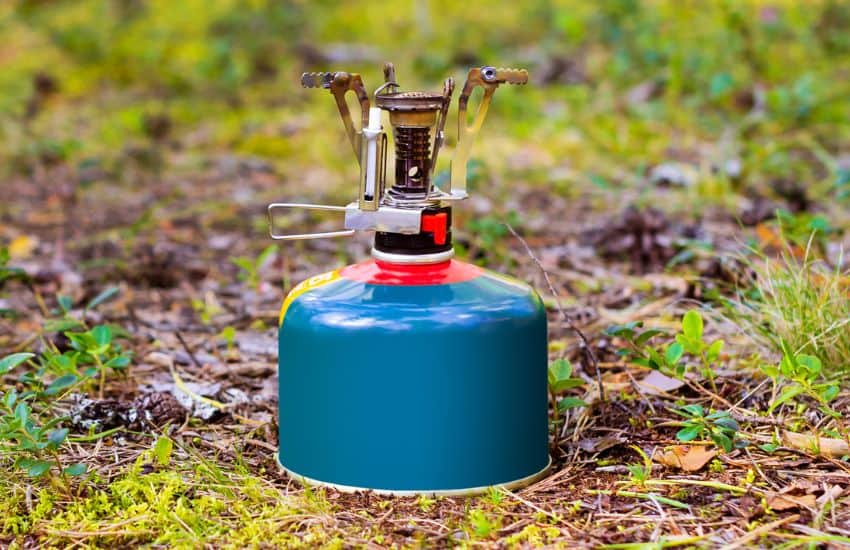
Gas fuel canisters have become a mainstay for campers seeking convenience and fuel efficiency. These canister fuels, typically a blend of propane and butane, are designed for ease of use: just attach the canister to your stove, turn on the valve, and you’re ready to cook.
The simplicity of camping gas canisters is matched by their clean-burning nature, leaving you with minimal soot and maintenance worries. Additionally, the self-sealing mechanism of these canisters provides a safe and worry-free experience, as it prevents leaks when disconnected from the stove.
Compact and lightweight, they are an excellent choice for backpackers who count every ounce.
However, their performance can wane in freezing temperatures, and the inability to gauge how much fuel remains can leave you guessing. Despite these considerations, for many outdoor enthusiasts, the convenience of gas canister fuels makes them a go-to choice for a quick and hassle-free meal in the wild.
Butane
Butane is a common choice for campers due to its lightweight properties and affordability. This type of fuel burns clean, leaving you with little to no residue on your cooking gear.
In milder conditions, butane canisters are efficient and reliable. However, they’re not the ideal choice for freezing temperatures as butane’s performance drops significantly as the mercury dips. This makes them suitable for summer camping trips or in climates where the cold isn’t a pressing concern.
Isobutane
Isobutane is a variant of the common fuel butane that has been refined to function better under pressure, making it more suitable for outdoor use where temperatures can fluctuate.
It has a lower boiling point than butane, allowing it to work more efficiently in cooler conditions — although not as well as propane.
For campers who prefer lighter fuel without the bulkiness of propane tanks, isobutane canisters are a compelling choice. They offer a middle ground, delivering enhanced performance in colder weather compared to butane, while still maintaining a lightweight and compact form factor that’s ideal for backpackers looking to conserve space and reduce pack weight.
Propane
Propane stands out for its ability to perform well in cold temperatures, making it a dependable choice for year-round camping. Its high vapour pressure ensures it continues to vaporize and feed your stove even when the temperature falls.
Cylinders designed to hold propane are typically heavier and more robust, which can add to your pack’s weight, but the trade-off comes in the form of consistent cooking power in varied conditions.
Blends
For those seeking a versatile solution, fuel blends that combine propane with butane offer a balanced option.
These mixtures aim to harness the benefits of both gases: the cold-weather performance of propane and the lighter weight and cost-effectiveness of butane.
Canisters containing blended fuels are particularly useful for three-season campers who might encounter a wide range of temperatures and need a fuel that can adapt. The result is a flexible fuel choice that can perform in a variety of environments without the need to switch between fuel types.
Liquid Fuels
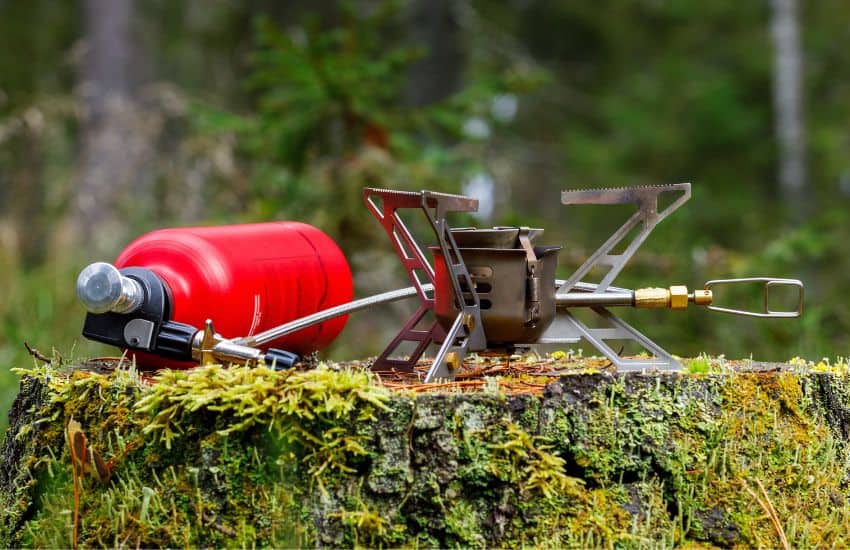
Liquid fuel stoves stand as the rugged workhorses of outdoor cooking, favoured for their reliability in diverse conditions.
These stoves, often referred to as multi fuel stoves, are designed to run on a variety of liquid fuels, including white gas, kerosene, jet fuel, and even unleaded gasoline. This versatility is a significant asset when travelling to remote areas where specific fuel canisters may not be available.
Liquid fuels generally offer a consistent burn rate, even in cold temperatures, making them a strong choice for winter camping or high-altitude expeditions.
Moreover, liquid fuel stoves allow for refilling from a shared fuel bottle, which can reduce waste and improve efficiency on longer trips.
While they require more maintenance and have a steeper learning curve than canister stoves, the robustness and flexibility of liquid fuel stoves make them a go-to for adventurers who find themselves cooking in challenging environments.
Other Fuels
Venturing beyond the most common choices, there’s a world of alternative fuels that cater to specific needs and scenarios for outdoor cooking. These other fuels, which might not be as widely known or used, can often provide unique benefits or fill particular niches.
Alcohol
Alcohol stoves are a minimalist camper’s friend, known for their simple design and the use of readily available fuels like denatured alcohol, methanol, or ethanol. The fuel is eco-friendly, with a clean burn that leaves minimal residue, making cleanup a breeze.
While alcohol stoves don’t offer the quickest cooking times and need wind protection, their lightweight and simplicity make them a popular choice for lightweight packers.
Solid Fuel Tablets
Solid fuel tablets are the epitome of convenience for weight-conscious campers. These simple-to-light tablets leave minimal mess and are good for basic cooking tasks. They’re not as hot as other fuels but excel in simplicity and reliability, perfect for straightforward cooking or as a backup.
Fuel Gel
Fuel gel, often coming in squeezable tubes or pre-filled pouches, is an easy-to-light option that burns cleanly. While it won’t give you the highest temperatures, its portability and safety make it a solid choice for those looking to minimize risks, particularly where flames are a concern.
Wood
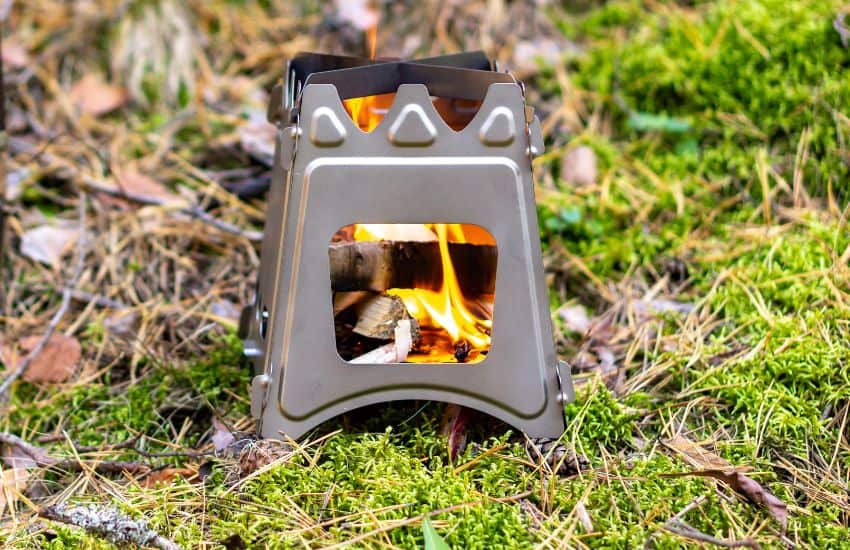
For those who prefer a traditional approach, wood remains a free and abundant fuel source in forested areas, requiring a specific wood burning stove, designed for solid biomass or established pit.
The availability of fuel is a clear advantage, though the variability of wood in size, moisture content, and type can affect its burning efficiency.
Cooking with wood also requires more skill to manage the fire and can produce smoke and soot, necessitating extra clean-up. However, for many, the rustic charm of cooking over a wood flame is an integral part of the outdoor experience.
Best Wood Stove
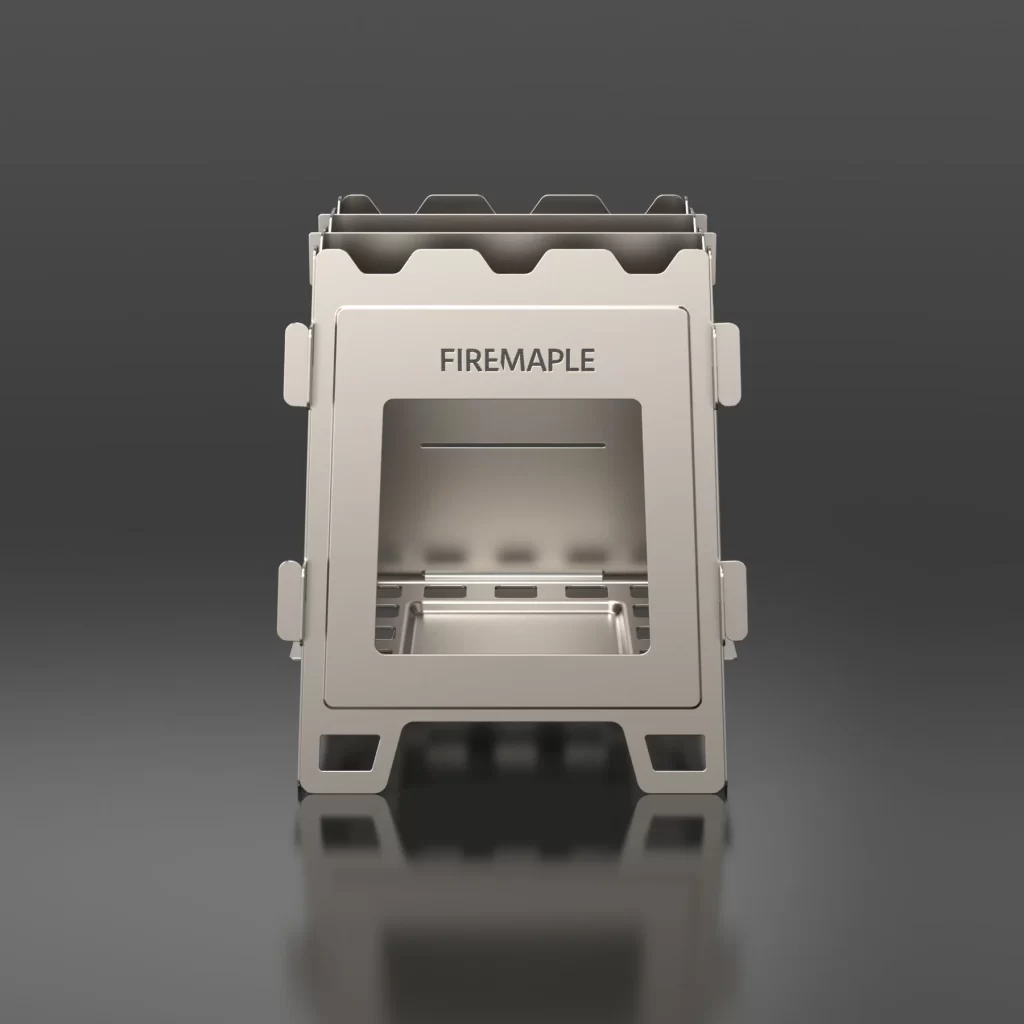
FireMaple’s Fortress Titanium Wood Stove
- Lightweight titanium stove weighing just 219g
- Quick and easy assembly in a snap, literally
- Compatible with various fuels, including firewood and alcohol.
Canister Gas Stoves Vs. Liquid Stoves
When choosing a camping stove, the debate between canister gas stoves and liquid fuel stoves is one that resonates with many outdoor enthusiasts.
Canister stoves are praised for their convenience and ease of use, offering a plug-and-play experience with minimal setup time.
On the flip side, liquid fuel stoves are valued for their versatility and consistent performance in varied climates, especially in freezing temperatures.
Each has its own set of advantages and considerations, affecting everything from the initial investment to long-term use and maintenance.
To help clarify this, let’s compare the two based on several key factors.
Weight
When it comes to the weight factor, canister gas backpacking stoves have an edge. They are designed to be lightweight and compact, making them a favourite among backpackers who monitor every ounce. The stove itself is typically just a small burner that attaches directly to the fuel canister.
Liquid fuel stoves, while offering robust performance, come with the added weight of a refillable fuel bottle and a more substantial burner structure. For those counting grams on long treks, the difference can be significant.
Cost
The initial cost of a canister stove is often lower than that of a liquid fuel stove. However, the ongoing expense of purchasing new gas canisters can add up, particularly for frequent campers.
Liquid fuel stoves represent a higher upfront investment but can be more economical over time. The ability to refill the same fuel bottle from a larger, more cost-effective fuel supply can mean greater savings as the miles and months add up.
Availability
Fuel availability is a crucial consideration, especially for those venturing into remote areas. Canister fuels are readily available in most outdoor or camping stores in well-traveled regions. Yet, they can be scarce or non-existent off the beaten path.
In contrast, the versatility of liquid fuel stoves means you can often find a compatible fuel – such as white gas or even unleaded petrol – almost anywhere in the world, which can be a lifesaver in less accessible locations.
Climate
The performance of your stove in various climates can be a deal-breaker. Canister stoves can struggle in cold temperatures as the fuel pressure drops, making them less reliable in winter conditions or at higher altitudes.
Liquid fuel stoves are generally impervious to the cold. They maintain consistent performance, regardless of the temperature, due to their pressurized fuel system, which is a major advantage in challenging weather conditions.
Maintenance
Maintenance is an aspect where canister stoves shine due to their simplicity. They require minimal upkeep – just connect the canister to the stove and light it up.
Liquid fuel stoves, on the other hand, demand more attention. They have more parts that can clog or wear out and typically require periodic cleaning and the replacement of o-rings and seals.
For those who prefer a set-it-and-forget-it approach, a canister stove might be the appealing choice, whereas hands-on enthusiasts who don’t mind tinkering may appreciate the durability and repairability of liquid fuel stoves.
Why You Should Use a Camping Stove Instead of a Campfire?
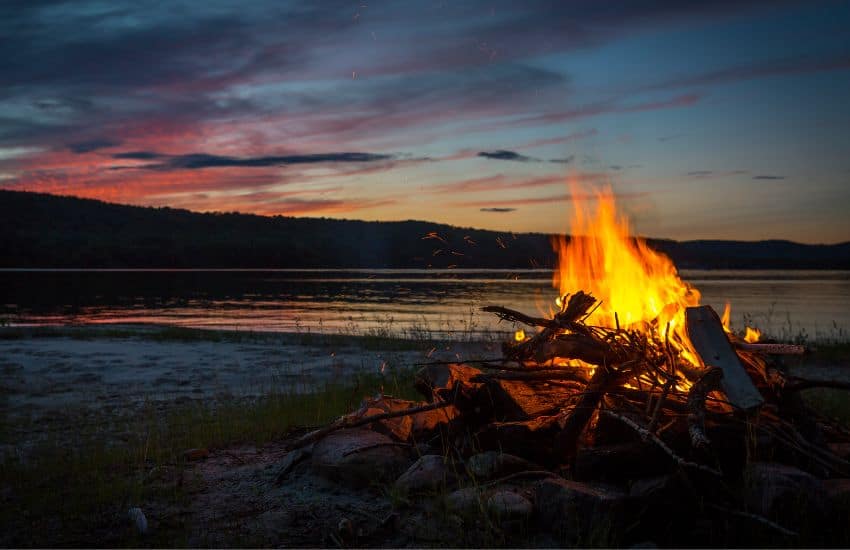
Opting for a camping stove over a traditional campfire can be a wise decision for several practical reasons. For starters, camping stoves offer a level of convenience and control that open fires simply can’t match; with a turn of a knob, you can adjust the heat instantly and precisely, ensuring your meals are cooked evenly and safely.
Additionally, they are often more environmentally friendly — they don’t scar the landscape with fire pits and avoid the risk of uncontrolled wildfires. In many locations, especially during dry seasons, campfires are banned due to this risk, but a camping stove can be used year-round.
Furthermore, stoves are quicker to set up and clean up, saving valuable time for hiking or enjoying the surroundings. When it comes to respecting leave-no-trace principles and minimizing the impact on the natural environment, a camping stove is clearly the responsible choice.
Final Thoughts
When choosing the right fuel for your camping stove, consider factors like burn efficiency, environmental impact, and convenience.
White gas and isobutane-propane canister fuels offer clean and efficient burning, while specialized fuels like ethanol represent the cleanest smokeless options.
Remember to use only recommended fuels in multi-fuel stoves to ensure safety and equipment longevity.
Happy camping!
Camping Stove Fuel Type FAQ
What is the cleanest burning fuel for camp stoves?
The cleanest burning fuel for camp stoves is typically isobutane-propane mixtures found in canister fuels. These fuels burn almost completely and produce very few soot particles or noxious fumes, making them a favourite for campers who prioritize environmental friendliness and ease of use.
What is the best fuel for a multi-fuel camp stove?
The best fuel for a multi-fuel camp stove is often white gas, also known as naphtha. It burns cleanly, efficiently, and works well in various conditions, including colder climates. White gas also has the benefit of being readily available and relatively inexpensive.
What is the cleanest smokeless fuel?
The cleanest smokeless fuel is often ethanol or bioethanol, as it burns very cleanly, releasing only water vapour and carbon dioxide, and does not produce smoke or leave a residue like soot.
What can you not burn in a multi-fuel stove?
You should not burn treated wood, plastic, or any materials containing harmful chemicals in a multi-fuel stove. These can release toxic fumes when burned and can also damage the stove’s components.
What is white gas called in the UK?
In the UK, white gas is commonly referred to as Coleman fuel or sometimes as naphtha. It’s widely used in camping stoves due to its high heat output and clean-burning properties.

About the Author
Steve Cleverdon is an outdoor adventure specialist with 15+ years of hiking, camping, and paddle boarding experience. He has conquered Europe’s toughest trails including the GR20 in Corsica, walked 3,000km solo across New Zealand, and worked professionally in the outdoors industry. Steve’s gear reviews and recommendations are based on real-world testing across four continents, from coastal waters to mountain peaks. Learn more about Steve or get in touch.